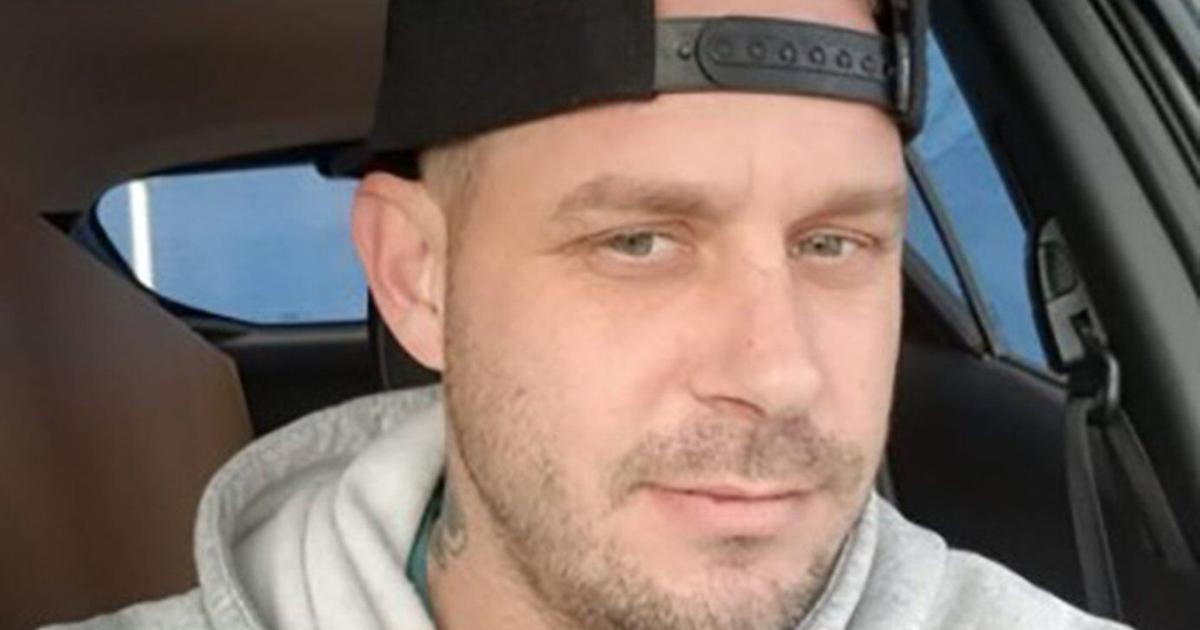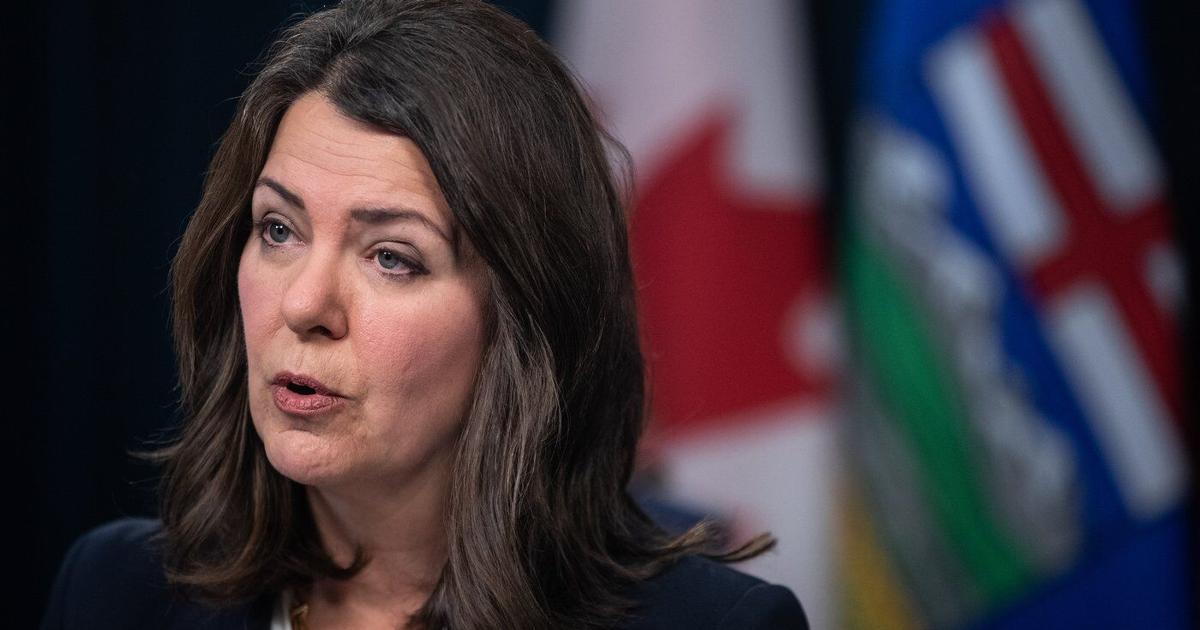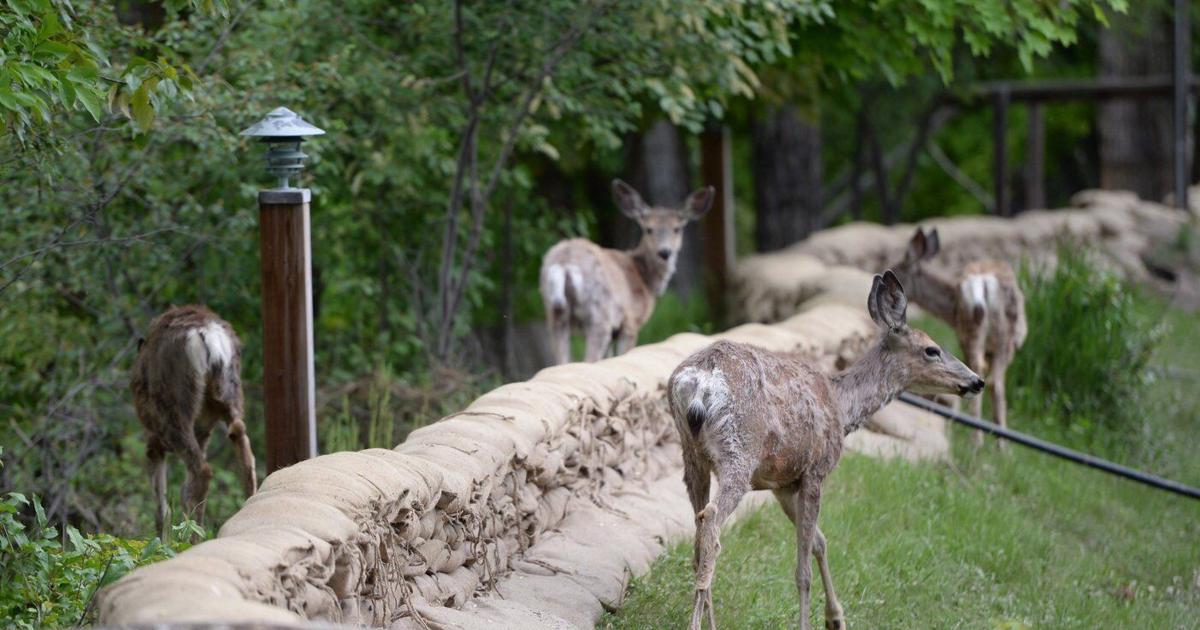News
A year into Russia’s invasion of Ukraine, has Canada done enough to help? – Global News

At Kozak Ukrainian Eatery in New Westminster, B.C., a jar sits next to the till, displaying a Ukrainian flag. A few loose coins sit inside.
Behind the counter, as the smell of fresh-baked pastries and simmering borscht wafts from the kitchen, Yana Naida doesn’t ask for a donation or acknowledge the jar. She smiles, thanks customers for their purchase, and continues on with her work.
The 19-year-old university student fled the Ukrainian town of Ternopil, outside of Lviv, three months after Russia launched its invasion on Feb. 24, 2022. She came to Canada because she not only knows English — it’s her major — but also because she knows the money she makes at Kozak will go a long way back home.
“For two dollars you can pay for a soldier’s supper,” she told Global News in an interview.
“I’m just a lot more useful here.”
Naida says she’s noticed a drop in donations for Ukraine, both in that jar by the register and in her other efforts to fundraise for Ukrainian-based charities over recent months. But she doesn’t doubt that Canadians, and the West overall, still supports her country.
“People can only give so much, especially after they gave so much at the start,” she said. “But people will ask about it at the store, when they hear my accent, and I know they still care.”
A year into the war — and with no end in sight — Canada and its Western allies are underscoring the need to keep helping Ukraine defend itself against Russia, despite the mounting economic cost.
Ipsos polling from January suggests people around the world remain supportive, although some signs of fatigue are showing. About two-thirds of those surveyed across 28 countries, including Canada, said they still follow news on the invasion closely, support taking in Ukrainian refugees and agree doing nothing in Ukraine will encourage Russia to invade elsewhere.
The support for refugees, however, has dipped seven points since March and April 2022, while the belief Russia will be encouraged if Ukraine is ignored is down five points.
But the poll also suggests Canadians are more willing to support Ukraine than most other countries surveyed. Canada was one of only three countries where a majority did not say their government can no longer afford to financially support Ukraine “given the current economic crisis” back home.
Those sentiments appear to be growing in countries like France, Germany, Poland, and Japan, according to the poll.
Ukrainian President Volodymyr Zelenskyy receives a standing ovation as he appears via videoconference to make an address to Parliament, in the House of Commons on Parliament Hill in Ottawa, on Tuesday, March 15, 2022. THE CANADIAN PRESS/Justin Tang.
THE CANADIAN PRESS/Justin Tang
Canadians surveyed were also more supportive of economic sanctions against Russia, despite the impact on gas and food prices, and even deploying NATO forces to nations surrounding Ukraine.
The steadfast support is also noticeable in the halls of Parliament. Unlike in the United States, where a sizeable group of Republicans are openly questioning sending more aid to Ukraine, politicians of all parties in Canada have largely remained supportive.
“Canadians are where they need to be on supporting Ukraine … which undergirds the political support,” said Orest Zakydalsky, a senior policy adviser for the Ukrainian Canadian Congress (UCC).
Over the past year, the UCC, which represents the largest Ukrainian diaspora outside of Russia — nearly 1.4 million Canadians identify as Ukrainian — has lobbied the Canadian government to do all it can to help the war effort. That has included military, financial and humanitarian support as well as fast-tracking the entry of Ukrainians fleeing the war to seek temporary residency in Canada.
Ukrainian nationals fleeing the ongoing war in Ukraine arrive at Trudeau Airport in Montreal, Sunday, May 29, 2022. THE CANADIAN PRESS/Graham Hughes.
THE CANADIAN PRESS/Graham Hughes
To date, Canada has provided over $5 billion to Ukraine, including more than $1 billion in military equipment and support.
The federal government has also paid nearly $290 million in direct financial assistance to Ukrainians arriving in Canada, and established a $500-million Ukrainian Sovereignty Bond to allow Canadians to essentially invest in Ukraine’s survival.
“In terms of economic support, in some ways, Canada has been a leader,” Zakydalsky said.
But he adds Canada still needs to do more, including further economic sanctions on Russia and the figures who support the war and peddle disinformation.
He also wants a firm commitment from the government to extend the Canada-Ukraine Authorization for Emergency Travel (CUAET) program, which fast-tracks the entry process for Ukrainians and their families fleeing the war for Canada, beyond the current March 31 deadline.
“It’s creating some concern both in our community and amongst Ukrainians in Europe and Ukraine that the program may end,” he said.

Since January 2022, 167,585 Ukrainians have arrived in Canada, including CUAET applicants and returning Canadian permanent residents. Over half a million applications through the CUAET program have been approved.
Immigration, Refugees and Citizenship Canada said in a statement to Global News it continues to “closely monitor the ongoing needs of Ukrainians,” but would not say if the CUAET program will be extended. The agency added some of the approved applicants who have not arrived in Canada have chosen to stay closer to home instead.
“We’re working very hard … at making sure people have some normalcy in their life,” Zakydalsky said, pointing to local efforts to help newly-arrived Ukrainians navigate filing their taxes, learning English and getting driver’s licenses. “This (uncertainty over CUAET) makes that work difficult.”
What happens to military support?
Zakydalsky is also pushing Ottawa to follow with the rest of NATO and continue to increase its military aid to Ukraine, including more advanced weapons and equipment.
But experts say that may prove to be difficult in the war’s second year.
“I think what this war has exposed is the limits of Canada’s military and Canada’s overall power,” said Andrew Rasiulis, a fellow at the Canadian Global Affairs Institute and a former official in the Department of National Defence.
After weeks of requests by Ukrainian President Volodymyr Zelenskyy for the West to send Leopard 2 battle tanks, Canada last month donated four out of the 112 currently owned by the Canadian Armed Forces, which includes 82 designed for combat.
Defence Minister Anita Anand left the door open to sending even more tanks in the future, though she also emphasized the need to ensure the Canadian Army has enough of the heavy weapons to train and defend the country and its NATO allies.
Rasiulis suspects that means Canada still needs to hold onto its remaining tanks to meet its commitment to upgrade the 2,000-soldier battlegroup it leads in Latvia to a brigade, which will mean boosting troops and equipment.
Canada’s military, along with other Western nations, is also facing a recruitment crisis that Chief of the Defence Staff Gen. Wayne Eyre has told Global News makes him worried about the “collective ability to defend democracy at large.”
“I am concerned, but I’m concerned for the wider West as well,” he said last month in an interview with The West Block.
Read more:
Military recruiting issues in West raise challenges for defending democracy: defence chief
Read next:
Part of the Sun breaks free and forms a strange vortex, baffling scientists
While it is supposed to be adding about 5,000 troops to regular and reserve forces to meet a growing list of demands, the military is instead short more than 10,000 trained members — meaning about one in 10 positions are currently vacant.
In addition to a lack of recruits, the Canadian military continues to face longstanding challenges in procuring new equipment, maintaining aging gear, and tracking down replacement parts.
One area where the military does not appear to be having recruitment issues is in its cybersecurity force, which has been tasked with combating Russian cyberattacks and other forms of online warfare since before the invasion began.
Read more:
Adopt ‘heightened’ vigilance on reports of Russia-linked hacks over Ukraine aid: CSE centre
Read next:
Exclusive: Widow’s 911 call before James Smith Cree Nation murders reveals prior violence
The head of that cyber force, Rear Adm. Lou Carosielli, told a parliamentary committee this month that his team has met recruitment targets over the past three years. That has allowed the Canadian Armed Forces to establish a cyber task force to help Ukraine defend itself from Russian hackers, and another as a permanent part of the Latvia brigade.
“The threat is not limited to Ukraine alone,” Carosielli said, noting the Latvia cyber force helps that country and other European allies in the cybersecurity sphere.
More recently, Canada’s military contributions to Ukraine have been largely focused on contracting and purchasing equipment from elsewhere rather than donating from its own stocks. This has included the procurement of over 200 armoured vehicles from Mississauga-based Roshel and the purchase of an American-made air defence system at a cost of $406 million.

Rasiulis says that will likely be the strategy going forward, while putting more weight behind further financial and humanitarian aid and bolstering Western support for other initiatives like prosecuting Russian war crimes.
“That’s where Canada, politically-speaking, would be best placed and I think is where they are now moving,” he said.
“Canada is still a peacetime economy. And that means … money is always a limitation. But maintaining that moral high ground is important and also cost-effective.”
Back in New Westminster, Naida says she will continue to send a sizeable portion of her wages to a few select charities in Ukraine focused on military aid, and others that provide direct assistance like meals, clothing and essential items to refugees who fled the war-torn east.
Any additional help she receives from Canadians — whether it be the government or the next customer who walks into Kozak — will be welcome, she adds.
“People need to live their own lives. I get it. I cannot ask for more,” she said. “We are doing everything we can.”
News
Safety board calls for changes two years after Nova Scotia fisherman’s death at sea

HALIFAX – An investigation into how the Canadian Coast Guard responded to a Nova Scotia vessel in distress two years ago raises questions about why one fisherman died after a towing operation went awry.
In an investigation report released Thursday, the Transportation Safety Board says the fishing boat Mucktown Girl was returning to Canso, N.S., with five crew aboard on March 11, 2022, when it was disabled by electrical problems.
The captain called for a tow from the coast guard as a storm was closing in.
After a seven-hour voyage, the Canadian Coast Guard Ship Jean Goodwill reached the drifting boat and attached a 300-metre tow line to the smaller vessel’s bollard. But as the weather turned rough, the bollard broke off six hours into the recovery mission.
At that point, the decision was made to let the fishing crew ride out the storm aboard the Mucktown Girl rather than attach another tow line that could damage the boat.
By 6 a.m. on March 13, wind speeds had reached 70 to 90 kilometres per hour. The waves were as high as 10 metres — twice the height of the fishing boat, which was then taking on water. Crew aboard Jean Goodwill relayed the mayday distress call from the fishing boat, which was 44 kilometres from shore.
Minutes later, amid heavy rain and dense fog, the five fishermen donned immersion suits and jumped into a life raft. In response, the coast guard crew lowered a scramble net — a type of rope ladder — over the side of the 77-metre medium icebreaker.
But the water was so rough, the net was washed back onto the ship several times. And as the ship rolled in the big swells, two coast guard crew members were injured and a number of others were almost swept overboard.
“As a result of the environmental conditions, communications broke down and affected the co-ordination of the (rescue effort),” the report says.
At the time, the air temperature was about 12 C, but the water temperature was only 4 C.
Four of the fishermen, including the captain, jumped from the life raft into the frothing water and managed to climb the ladder to safety. But the fifth crewman, 35-year-old Jeremy Hart of Windsor Junction, N.S., drifted to the stern of the coast guard ship and disappeared.
The father of two boys was pulled from the water five hours later by the crew aboard a Cormorant search and rescue helicopter, but he was later declared dead at a Cape Breton hospital.
The report from the independent safety board says there are no Canadian regulations for the towing points on fishing vessels.
“Without specific guidance for assessing the risks to the towed vessel and its crew, the (coast guard) may underestimate risks and tow vessels with crew on board in hazardous conditions, resulting in an increased likelihood of injuries and loss of life,” the report says.
But the report does not call for any changes, aside from updating the coast guard’s towing waiver, which explains the responsibilities of those involved and the risks.
More importantly, the report highlights the fact that once the bollard broke, it became clear there were no plans in place to remove the crew from the fishing boat.
“Without comprehensive contingency planning for towing disabled vessels, risks to rescuers as well as crews of vessels under tow may be increased,” the report says.
The safety board’s investigation found that the coast guard’s search and rescue (SAR) training typically involves the use of small, fast-rescue craft rather than larger vessels like the Jean Goodwill.
“There is limited vessel-specific SAR training such as the use of scramble nets,” the report says. “(This) training does not reflect the realistic conditions and equipment in a rescue operation, where factors can change unpredictably. For example, training is carried out in good weather only, and in … overboard exercises, only one person at a time needs rescue.”
As for the scramble net, the report says it was not suitable for the deplorable conditions that faced the coast guard crew in 2022.
“Although scramble nets do not have specified restrictions for use, they are difficult to climb in rough conditions,” the board says. “They are also difficult to climb in an immersion suit, even in calm weather, and are not usable if a person is injured or incapacitated.”
That’s why the coast guard has already installed a so-called rescue scoop on the Jean Goodwill. The hydraulic device uses an extendable arm to dip a scramble net into the water on its side, allowing the operator to scoop up victims.
The device has been used on other coast guard vessels in the past, and the federal agency is looking at acquiring more.
“Without emergency drills using realistic scenarios, and their subsequent evaluation, vessel crews may not have the most effective equipment and may not be well prepared to use it in the safest and most effective manner,” the report says.
This report by The Canadian Press was first published Nov. 21, 2024.
News
Alberta pitches new rules for auto insurance, including rate hikes, no-fault claims

EDMONTON – The Alberta government is making changes to auto insurance, including rate hikes and switching to a predominantly no-fault claims model.
Premier Danielle Smith announced the changes at a news conference in the legislature.
Under the new system, car accident victims in most cases won’t be able to sue the party responsible for their injury and, instead, insurers would pay compensation at rates set by the government.
By cutting down litigation costs, the government estimates that when the new system is in place in 2027, it could lead to savings of up to $400 per year for the average insurance premium.
It’s also promising better support and benefits for those hurt in collisions.
Until the new model kicks in, insurers would be allowed to raise rates for good drivers up to 7.5 per cent each year, starting in January.
This report by The Canadian Press was first published Nov. 21, 2024.
The Canadian Press. All rights reserved.
News
Third deer infected with chronic wasting disease in B.C.

VICTORIA – A new case of chronic wasting disease, an incurable illness that has the potential to decimate deer populations, has been identified in British Columbia.
The B.C. Ministry of Water, Land and Resource Stewardship says the discovery of the infection in a white-tailed deer hunted in the Kootenay region last month brings the total number of confirmed cases in the province to three, after two cases were confirmed in February.
It says testing by a Canadian Food Inspection Agency lab confirmed the latest infection on Wednesday.
The ministry says the new case occurred within two kilometres of one of the earlier infections in a white-tailed deer near Cranbrook.
Wasting disease affects deer, elk, moose and caribou. It attacks their central nervous system and causes cell death in the brain.
The ministry says there is no treatment or vaccine and the disease is always fatal.
The ministry says there is no direct evidence the disease can be transmitted to humans, but Health Canada recommends people do not eat meat from an infected animal, since cooking is not able to destroy the abnormal protein that causes the illness.
In July, the B.C. government introduced mandatory testing for the disease in deer, elk and moose killed in certain zones in the Kootenay region.
The first two cases identified in B.C. were a male mule deer killed by a hunter and a female white-tailed deer killed in a road accident.
Other steps included removing urban deer from Cranbrook and Kimberley.
This report by The Canadian Press was first published Nov. 21, 2024.
The Canadian Press. All rights reserved.
-

 News22 hours ago
News22 hours agoEstate sale Emily Carr painting bought for US$50 nets C$290,000 at Toronto auction
-

 News21 hours ago
News21 hours agoClass action lawsuit on AI-related discrimination reaches final settlement
-

 News22 hours ago
News22 hours agoCanada’s Hadwin enters RSM Classic to try new swing before end of PGA Tour season
-

 News23 hours ago
News23 hours agoAll premiers aligned on push for Canada to have bilateral trade deal with U.S.: Ford
-

 News22 hours ago
News22 hours agoTrump nominates former congressman Pete Hoekstra as ambassador to Canada
-

 News22 hours ago
News22 hours agoFormer PM Stephen Harper appointed to oversee Alberta’s $160B AIMCo fund manager
-

 News22 hours ago
News22 hours agoEx-student pleads guilty to fatally shooting 3 University of Virginia football players in 2022
-

 News21 hours ago
News21 hours agoComcast to spin off cable networks that were once the entertainment giant’s star performers






















